Freestanding Freezer: What should I do when my freezer's high-temperature alarm sounds?
The high-temperature alarm sounds when the temperature inside the freezer rises 15 degrees above the set temperature so that you can fix the cooling problem and prevent food spoilage. (The exact temperature rise that triggers the alarm varies by model.)
When you hear the alarm, check the freezer electrical outlet for power because the control uses a battery as back-up power to sound the alarm (on most models) when the outlet power fails. Restore power to the freezer by resetting the house circuit breaker for the electrical outlet and the freezer will resume cooling if a power failure caused the alarm.
If the alarm goes off and you hear the compressor running, a sealed system problem such as a refrigerant leak or a failed compressor pump may be causing the problem. Have a service technician examine the freezer if you suspect a sealed system failure. A service technician will need to diagnose and fix a sealed system failure because the repair involves the recovery and recharge of the refrigerant.
If the evaporator fan inside the freezer runs but the compressor doesn't run, a failed start relay on the compressor could be preventing it from starting. Most relays will rattle if they're bad. Unplug the freezer and pull off the start relay and shake it. If it rattles, try replacing the relay to get the compressor started and the freezer cooling again. This tactic won't work for all freezer models, but it may work for your freezer if you're desperate to keep food in the freezer from spoiling and can't get a service technician to repair the freezer right away.
If the freezer cools but doesn't cool down to the set temperature, a failed thermistor may be inaccurately detecting freezer temperature or the electronic control board in the freezer may be inaccurately detecting the thermistor signal. If the freezer compartment is actually at 0 degrees when the high-temperature alarm sounds, a failed thermistor or bad electronic control board likely caused the alarm by inaccurately detecting freezer temperature.
Problems in the automatic defrost system can also prevent the freezer from cooling and trigger the high-temperature alarm. If the defrost heating element that melts frost off the evaporator fins fails, frost will cake up on the evaporator fins and interfere with cooling airflow in the freezer. A failed defrost bi-metal won't allow current to reach the heater so a failed defrost bi-metal will also inhibit cooling in the freezer. A failed defrost timer won't advance into the automatic defrost mode so the defrost heating element would never turn on to melt frost off the evaporator fins.
A failed evaporator fan can also cause cooling problems because it won't circulate air through the freezer cabinet. Replace the evaporator fan if it doesn't run when activated.
Clean dirty condenser coils because dirty coils won't cool down refrigerant before it enters the evaporator, resulting in poor cooling performance. Replace the condenser fan if it isn't running when the compressor runs because the condenser fan blows air across the condenser to help cool the refrigerant before it enters the evaporator.
Sometimes, lack of maintenance can cause cooling problems and trigger the high-temperature alarm. Perform routine maintenance on the freezer such as cleaning the door or lid seal to keep warm air from entering the freezer and triggering the alarm.

THESE REPAIRS MAY HELP SOLVE YOUR FREESTANDING FREEZER PROBLEM
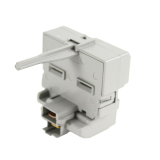
Replace the freezer start relay and overload
The compressor start relay starts the compressor and keeps it running until the compressor cycles off. Replace the start relay if it's broken and the compressor doesn't run. In some situations, a wiring failure could be causing the problem, and repairing the start relay wiring will fix the problem.
Freezer start relay and overload
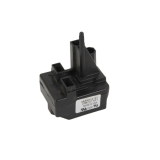
How to replace a freezer compressor start relay
If your freezer isn't cold and you don't hear the compressor running, the compressor start relay might be burnt out. This DIY repair guide explains how to replace a freezer compressor start relay in 15 minutes or less.
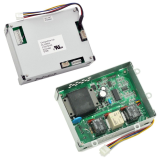
Replace the freezer electronic control board
The electronic control board-also called the main control board or the power control board (PCB)-manages the compressor and the defrost cycle. The control board activates the compressor to keep the freezer cold and runs the fans. The electronic control board monitors temperature sensors to control freezer temperature and the defrost cycle. Replace the electronic control board if it's not working properly.
Freezer electronic control board
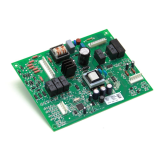
How to replace a freezer electronic control board
If your freezer isn't cold and you don't hear the fans or compressor running, the electronic control board could be the problem. This step-by-step repair guide and video show how to replace a freezer electronic control board.
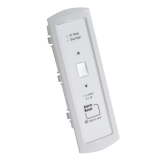
Replace the freezer control panel
The control panel houses the selection buttons and the display for the freezer. The control panel communicates with the electronic control board through a wire cable. Check the wire cable connections before replacing the control panel. Replace the control panel when keys are stuck or the display doesn't work.
Freezer control panel
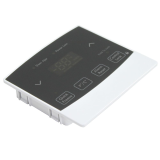
How to replace a freezer control panel
An upright freezer control panel that doesn’t show the temperature or respond when you press the buttons could be broken. This DIY repair guide and video show how to replace an upright freezer control panel in less than 15 minutes.
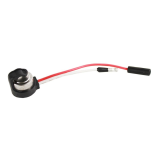
Replace the freezer defrost bi-metal
The freezer defrost sensor-also known as the defrost bi-metal or defrost termination thermostat-is next to the evaporator. It trips when the evaporator temperature gets too high, to protect the evaporator from overheating. When it trips, the defrost bi-metal shuts off the defrost heater. A defective defrost bi-metal prevents the defrost heater from working, causing frost to build up on the evaporator, causing a warmer freezer interior. Replace the defrost sensor if it prevents the defrost heater from working.
Freezer defrost bi-metal
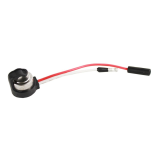
How to replace a freezer defrost thermostat
If your upright freezer isn't cooling and its interior back wall is covered with frost, the defrost thermostat could be the problem. This repair guide and video show how to replace a freezer defrost thermostat with step-by-step instructions.
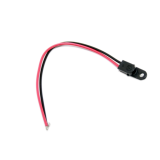
Replace the freezer thermistor
The thermistor is a temperature sensor inside the freezer. The electronic control board uses the reading from the thermistor to cycle the compressor on and off to maintain freezer temperature. Replace the thermistor if it's not sensing freezer temperature accurately.
Freezer thermistor
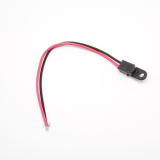
How to replace a freezer thermistor
If your freezer is too cold or not cold enough, the thermistor might be to blame. This easy-to-follow repair guide and video show how to replace a freezer thermistor.
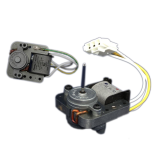
Replace the freezer evaporator fan
The evaporator fan mounts on the evaporator assembly. It moves air across the evaporator fins and through the cabinet for cooling. The freezer won't cool properly when the evaporator fan breaks. If the evaporator fan doesn't run when activated, replace it.
Freezer evaporator fan
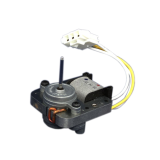
How to replace a freezer evaporator fan
If your freezer is warm and you don't hear the hum of a fan, the evaporator fan could be broken. This DIY repair guide and video show how to replace a freezer evaporator fan in 6 steps.
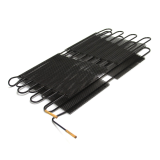
Clean the freezer condenser coils
Dust-covered freezer coils prevent the freezer from running efficiently and cooling properly. Unplug the freezer and clean the condenser coils using a coil brush. Vacuum up the dust. Clean the grill below the freezer door to allow proper air flow to the condenser.
Clean the freezer condenser coils
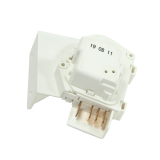
Replace the freezer defrost timer
The defrost timer controls the intervals between defrost cycles and limits the length of the cycle. During the defrost session, the timer activates the defrost heating element and prevents the compressor from running, so frost melts from the evaporator fins. Replace the defrost timer if it doesn't control the defrost heater and compressor properly.
Freezer defrost timer
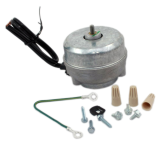
Replace the freezer condenser fan motor
The condenser fan is in the machine compartment of the freezer next to the compressor. It moves air across the condenser coils to help cool the hot refrigerant coming out of the compressor. Replace the condenser fan if it fails to run when activated.
Freezer condenser fan motor
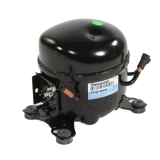
Replace the freezer compressor
The compressor is a pump that an electric motor rotates. The compressor is the problem if the motor won't start when the start relay actives it, or if the motor runs but the pump doesn't compress the refrigerant. Have a service technician replace the compressor, because this repair requires access to the sealed refrigerant system.
Freezer compressor
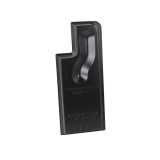
Perform freezer routine maintenance
Routine maintenance keeps your freezer working efficiently. Clean the bottom front grill and the condenser coils regularly to help the freezer cool better and use less energy. Adjust the freezer door if it's not sealing properly. Lubricate the door seal with a light coat of petroleum jelly occasionally to prevent air leaks into the freezer.
Perform freezer routine maintenance
Most common symptoms to help you fix your freestanding freezers
Choose a symptom to see related freezer repairs.
Main causes: burned out light bulb, bad door or lid switch, faulty LED light board, wiring failure, control system failu…
Main causes: lack of power, bad compressor, refrigerant leak, bad thermistor, defrost system failure, dirty condenser co…
Main causes: compressor failure, no refrigerant, faulty sensor, control failure, broken defrost heater, bad defrost bi-m…
Main causes: damaged door or lid gasket, cracked cabinet liner, bad defrost bi-metal thermostat, broken defrost heater, …
Main causes: excessive frost, bad defrost heater, bad defrost bi-metal, control system failure, low refrigerant charge, …
Main causes: dirty condenser coils, condenser fan failure, dirty bottom front grill, leaky door or lid gasket…
Main causes: lack of power, control system failure, broken compressor start relay, locked up compressor, compressor moto…
Main causes: leaky door or lid gasket, broken defrost heater, bad defrost bi-metal thermostat, defrost control failure, …
Most common repair guides to help fix your freestanding freezers
Effective articles & videos to help repair your freestanding freezers
Use the advice and tips in these articles and videos to get the most out of your freezer.

Learn about all the convenient features on our Sears PartsDirect website that make your parts purchases easier.…
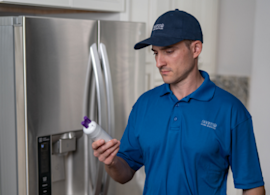
Get answers to frequently asked questions about Sears and Sears PartsDirect.…
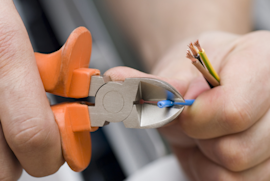
Learn how to repair broken, frayed or damaged wires in your appliances.…
